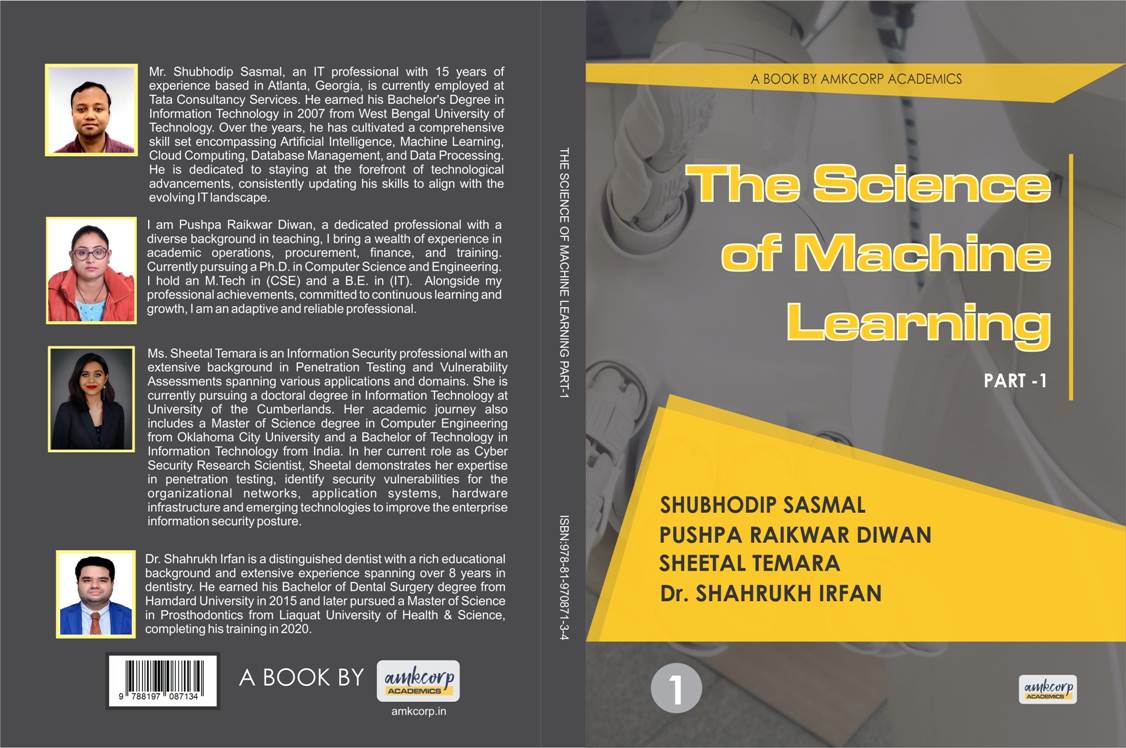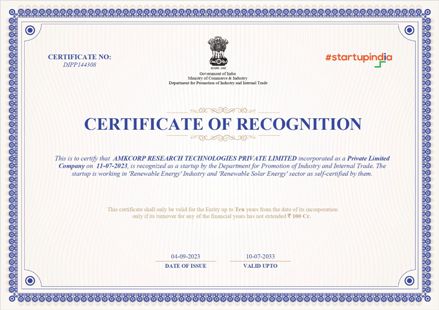
THE SCIENCE OF MACHINE LEARNING
PART 1
AUTHOR(S) -
SHUBHODIP SASMAL, PUSHPA RAIKWAR DIWAN, SHEETAL TEMARA, Dr. SHAHRUKH IRFAN,
DOI – 10.61909/AMKEDTB022411
Genre/Subject – Computer Science, ML, AI
Series – Machine Learning
Book code – AMKEDTB022411
ISBN(P) – 978-81-970871-3-4
ISBN(E) – 978-81-970871-8-9
Tentative Publication Date – 29-02-2024
AUTHOR(S)

SHUBHODIP SASMAL
Mr. Shubhodip Sasmal, an IT professional with 15 years of experience based in Atlanta, Georgia, is currently employed at Tata Consultancy Services. He earned his Bachelor’s Degree in Information Technology in 2007 from West Bengal University of Technology. Over the years, he has cultivated a comprehensive skill set encompassing Artificial Intelligence, Machine Learning, Cloud Computing, Database Management, and Data Processing. He is dedicated to staying at the forefront of technological advancements, consistently updating his skills to align with the evolving IT landscape. His proficiency extends beyond technical expertise, as he actively engages in professional development, contributing to a culture of continuous learning. With a track record of successfully leading initiatives and collaborating with cross-functional teams, he is passionate about leveraging his knowledge and experience to drive innovation in the dynamic realm of Information Technology.

PUSHPA RAIKWAR DIWAN
I am Pushpa Raikwar Diwan, a dedicated professional with a diverse background in teaching, I bring a wealth of experience in academic operations, procurement, finance, and training. Currently pursuing a Ph.D. in Computer Science and Engineering. I hold an M.Tech in (CSE) and a B.E. in (IT). Alongside my professional achievements, committed to continuous learning and growth, I am an adaptive and reliable professional.

SHEETAL TEMARA
Ms. Sheetal Temara is an Information Security professional with an extensive background in Penetration Testing and Vulnerability Assessments spanning various applications and domains. She is currently pursuing a doctoral degree in Information Technology at University of the Cumberlands. Her academic journey also includes a Master of Science degree in Computer Engineering from Oklahoma City University and a Bachelor of Technology in Information Technology from India. In her current role as Cyber Security Research Scientist, Sheetal demonstrates her expertise in penetration testing, identify security vulnerabilities for the organizational networks, application systems, hardware infrastructure and emerging technologies to improve the enterprise information security posture. She excels in conducting security risk assessments ensuring compliance with corporate information security policies and communicating risks effectively to stakeholders. Prior to her current position, Sheetal served as a Security Engineer where she conducted dynamic application security testing and provided expert guidance on security vulnerabilities and risks to development teams. She has extensive experience in utilizing various penetration testing tools and possesses advanced skills in programming languages. With a passion for cybersecurity and a dedication to advancing the field, Sheetal’s research interests incline toward the development of innovative solutions to address emerging cyber threats. She actively contributes to the academic community through her research publications and publishes her academic work on platforms such as ResearchGate. Outside of her professional endeavours, Sheetal is committed to sharing her knowledge and expertise with others. As an author, she aims to empower readers with practical insights and strategies to enhance their understanding of cybersecurity and strengthen their defenses against evolving threats.

Dr. SHAHRUKH IRFAN
Dr. Shahrukh Irfan is a distinguished dentist with a rich educational background and extensive experience spanning over 8 years in dentistry. He earned his Bachelor of Dental Surgery degree from Hamdard University in 2015 and later pursued a Master of Science in Prosthodontics from Liaquat University of Health & Science, completing his training in 2020. Currently enrolled in an MS program focusing on healthcare and management, Dr. Irfan’s dedication to professional growth is evident. His expertise extends beyond dentistry, encompassing areas such as natural language processing, data mining, and machine learning applications in healthcare, reflecting his multidisciplinary approach to knowledge acquisition and technology exploration. Dr. Irfan’s dynamic pursuit of emerging technologies and advancements in dentistry exemplifies his commitment to excellence in patient care and professional development.
ABOUT BOOK / ABSTRACT
The book titled “The Science of Machine Learning” serves as a comprehensive guide for both beginners and experienced practitioners in the field of machine learning. Covering a wide range of topics, the book provides a thorough introduction to the fundamentals of machine learning, as well as advanced techniques and emerging trends.
In the first chapter, readers are introduced to the concept of machine learning, its historical context, and its importance and applications in various domains. The chapter also explores different types of machine learning and addresses key terminologies, challenges, and limitations associated with the field.
The second chapter delves into the mathematical foundations essential for understanding machine learning algorithms. Topics covered include linear algebra, probability and statistics, calculus, optimization techniques, information theory basics, and numerical methods and algorithms.
Moving forward, the book explores data preprocessing and exploration techniques in Chapter 3. Readers learn about data cleaning, handling missing values, feature scaling, normalization, feature engineering, exploratory data analysis (EDA), data visualization, and dimensionality reduction methods.
Chapters 4 and 5 focus on supervised and unsupervised learning algorithms, respectively. Readers are introduced to popular algorithms such as linear regression, logistic regression, decision trees, random forests, support vector machines (SVM), k-nearest neighbors (k-NN), and ensemble methods for supervised learning, as well as k-means clustering, hierarchical clustering, Gaussian mixture models (GMM), principal component analysis (PCA), t-distributed stochastic neighbor embedding (t-SNE), and association rule learning for unsupervised learning.
Chapter 6 explores neural networks and deep learning, covering topics such as artificial neural networks (ANN), convolutional neural networks (CNN), recurrent neural networks (RNN), long short-term memory (LSTM), and generative adversarial networks (GAN).
In Chapter 7, readers learn about model evaluation and validation techniques, including cross-validation, performance metrics, bias-variance tradeoff, hyperparameter tuning, model interpretability, and explainability.
Chapter 8 focuses on feature selection and model interpretability, discussing the importance of feature selection, techniques for feature selection, interpretable machine learning models, explainable AI (XAI) techniques, model debugging, error analysis, and visualization of model decisions.
Chapters 9 and 10 delve into natural language processing (NLP) and computer vision, respectively, covering topics such as text preprocessing techniques, word embeddings, recurrent neural networks for NLP, transformer models, image preprocessing techniques, convolutional neural networks for image classification, object detection, image segmentation, and transfer learning.
Chapter 11 introduces readers to reinforcement learning, discussing concepts such as Markov decision processes (MDP), Q-learning, policy gradient methods, deep reinforcement learning, and applications of reinforcement learning.
In Chapter 12, readers learn about deploying machine learning models, including model deployment strategies, containerization and orchestration, model serving platforms, monitoring and scaling machine learning systems, ethical considerations in model deployment, and model maintenance and updates.
Finally, Chapter 13 explores future trends and directions in machine learning, including the current state of machine learning research, emerging technologies and innovations, and ethical and societal implications of machine learning. The chapter concludes with final thoughts and reflections on the future of the field.
Overall, “The Science of Machine Learning” provides a comprehensive overview of the field, equipping readers with the knowledge and skills necessary to embark on their journey in machine learning and stay abreast of the latest advancements and trends.








